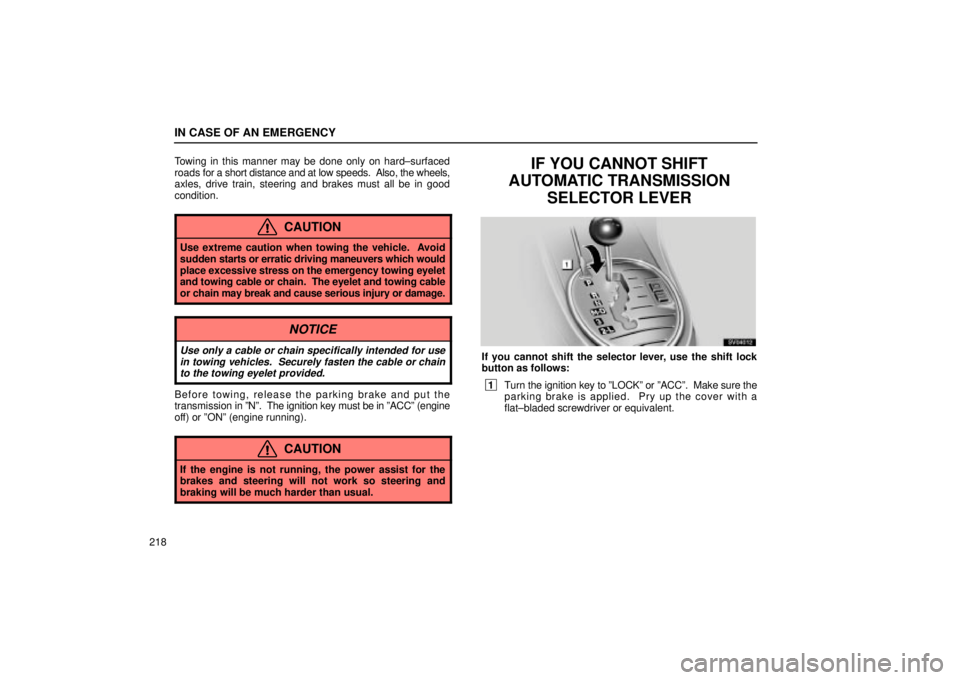Page 231 of 307

IN CASE OF AN EMERGENCY
218Towing in this manner may be done only on hard±surfaced
roads
for a short distance and at low speeds. Also, the wheels,
axles, drive train, steering and brakes must all be in good
condition.
CAUTION
Use extreme caution when towing the vehicle. Avoid
sudden starts or erratic driving maneuvers which would
place excessive stress on the emergency towing eyelet
and towing cable or chain. The eyelet and towing cable
or chain may break and cause serious injury or damage.
NOTICE
Use only a cable or chain specifically intended for use in towing vehicles. Securely fasten the cable or chainto the towing eyelet provided.
Before towing, release the parking brake and put the
transmission in ºNº. The ignition key must be in ºACCº (engine
off) or ºONº (engine running).
CAUTION
If the engine is not running, the power assist for the
brakes and steering will not work so steering and
braking will be much harder than usual.
IF YOU CANNOT SHIFT
AUTOMATIC TRANSMISSION SELECTOR LEVER
SV04012
If you cannot shift the selector lever, use the shift lock
button as follows:
1Turn the ignition key to ºLOCKº or ºACCº. Make sure the
parking brake is applied. Pry up the cover with a
flat±bladed screwdriver or equivalent.
Page 237 of 307

MAINTENANCE
224Tire rotation
Rotate the tires according to the maintenance schedule. (For
scheduled maintenance information, please refer to the
ªOwner's Manual Supplementº or ªScheduled Maintenanceº.)
See page 255 for additional information.
Fluid leaks
Check under
neath for leaking fuel, oil, water or other fluid after
the vehicle has been parked for a while. If you smell fuel fumes
or notice any leak, have the cause found and corrected
immediately.
Doors and engine hood
Check that all doors, including trunk lid, operate smoothly and
all latches lock securely. Make sure the engine hood
secondary latch secures the hood when the primary latch is
released.
Vehicle interior
Items listed below should be checked regularly, e.g. while
performing periodic services, cleaning the vehicle, etc.
Lights
Make sure the headlight, stop lights, tail lights, turn signal
lights, and other lights are working. Check headlight aim.
Service reminder indicators and warning buzzers
Check that all service reminder indicators and warning
buzzers function properly. Steering wheel
Check that it has the specified free play. Be alert for changes
in steering condition, such as hard steering, excessive free
play or strange noise.
Seats
Check that all front seat controls such as seat adjusters,
seatback recliner, etc. operate smoothly. Ch
eck that the head
restraints move up and down smoothly and that the locks hold
securely in any latched position.
Seat belts
Check that the seat belt system such as buckles, retractors
and anchors operate properly and smoothly. Make sure the
belt webbing is not cut, frayed, worn or damaged.
Accelerator pedal
Check the pedal for smooth operation and uneven pedal ef fort
or catching.
Brake pedal
Check the pedal for smooth operation and the proper
clearance and free play. Check the brake booster function.
Brakes
At a safe place, check that the brakes do not pull to one side
when applied.
Parking brake
Check that the lever has the proper travel and that, on a safe
incline, your vehicle is held securely with only the parking
brake applied.
Page 238 of 307

MAINTENANCE
225
Automatic transmission ºParkº mechanism
On a safe incline, check that your vehicle is held securely with
the selector lever in ºPº position and all brakes released.
Engine compartment
Items listed below should be checked from time to time,
e.g. each time when refueling.
Washer fluid
Make
sure there is sufficient fluid in the tank. See page 274 for
additional information.
Engine coolant level
Make sure the coolant level is between the Upper and Lower
lines on the see±through reservoir when the engine is cold.
See page 245 for additional information.
Battery
Your Lexus has a maintenance free battery. You do not have
to add distilled water. For longer life of the battery, however,
see page 268 for additional information.
Brake fluid level
Make sure the brake fluid level is correct. See page 252 for
additional information.
Engine oil level
Check the level on the dipstick with the engine turned off and
the vehicle parked on a level spot. See page 242 for additional
information. Power steering fluid level
Check the level on the dipstick. The level should be in the
ºHOTº or ºCOLDº range depending on the fluid temperature.
See page 253 for additional information.
Exhaust system
If you notice any change in the sound of the exhaust or smell
exhaust fumes, have the cause located and corrected
immediately. (See ªEngine exhaust cautionsº on page 165 in
Section 3±1.)
Page 262 of 307
CHASSIS
249
± BRAKES
Pedal clearance *
1
Pedal free play
Brake pad wear limit
Parking brake lining wear limit
Parking brake adjustment *
2
Fluid type
99 mm (3.9 in.) Min.
1 ± 6 mm (0.04 ±0.24 in.)
1.0 mm (0.04 in.)
1.0 mm (0.04 in.)
5 ± 8 clicks
SAE J1703 or FMVSS No. 116 DOT 3
*1Minimum pedal clearance when depressed with the force of 490 N (49 kgf,\
110 lbf.) with the engine running
*
2Parking brake adjustment when pulled with the force of 196 N (20 kgf, 4\
4 lbf.)
± STEERING Free play
Power steering fluid
Less than 30 mm (1.2 in.)
Automatic transmission fluid DEXRON�II or III